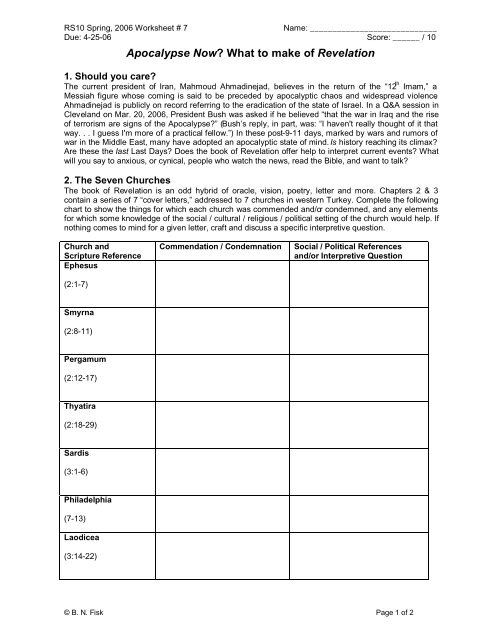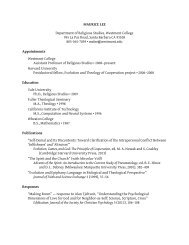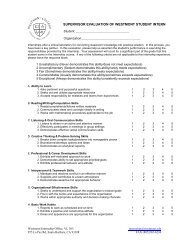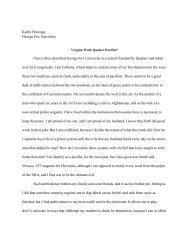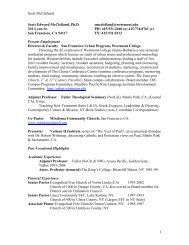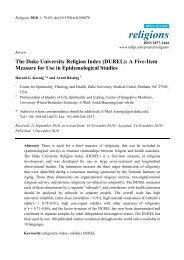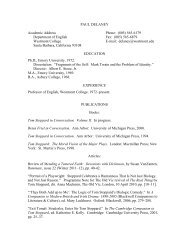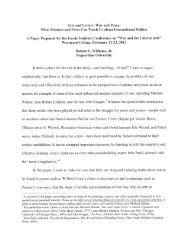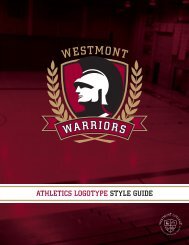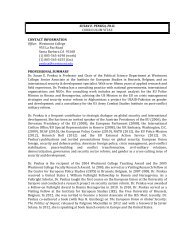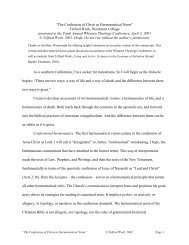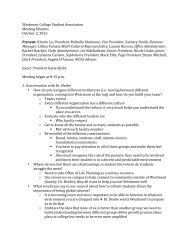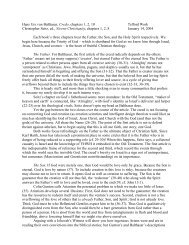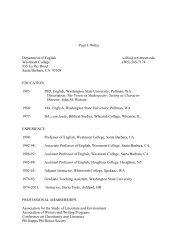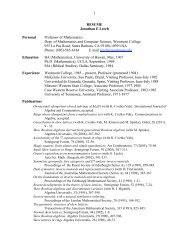Apocalypse Now? What to make of Revelation
Apocalypse Now? What to make of Revelation
Apocalypse Now? What to make of Revelation
Create successful ePaper yourself
Turn your PDF publications into a flip-book with our unique Google optimized e-Paper software.
RS10 Spring, 2006 Worksheet # 7<br />
Name: ____________________________<br />
Due: 4-25-06 Score: ______ / 10<br />
<strong>Apocalypse</strong> <strong>Now</strong> <strong>What</strong> <strong>to</strong> <strong>make</strong> <strong>of</strong> <strong>Revelation</strong><br />
1. Should you care<br />
The current president <strong>of</strong> Iran, Mahmoud Ahmadinejad, believes in the return <strong>of</strong> the “12 th Imam,” a<br />
Messiah figure whose coming is said <strong>to</strong> be preceded by apocalyptic chaos and widespread violence.<br />
Ahmadinejad is publicly on record referring <strong>to</strong> the eradication <strong>of</strong> the state <strong>of</strong> Israel. In a Q&A session in<br />
Cleveland on Mar. 20, 2006, President Bush was asked if he believed “that the war in Iraq and the rise<br />
<strong>of</strong> terrorism are signs <strong>of</strong> the <strong>Apocalypse</strong>” (Bush’s reply, in part, was: “I haven't really thought <strong>of</strong> it that<br />
way. . . I guess I'm more <strong>of</strong> a practical fellow.”) In these post-9-11 days, marked by wars and rumors <strong>of</strong><br />
war in the Middle East, many have adopted an apocalyptic state <strong>of</strong> mind. Is his<strong>to</strong>ry reaching its climax<br />
Are these the last Last Days Does the book <strong>of</strong> <strong>Revelation</strong> <strong>of</strong>fer help <strong>to</strong> interpret current events <strong>What</strong><br />
will you say <strong>to</strong> anxious, or cynical, people who watch the news, read the Bible, and want <strong>to</strong> talk<br />
2. The Seven Churches<br />
The book <strong>of</strong> <strong>Revelation</strong> is an odd hybrid <strong>of</strong> oracle, vision, poetry, letter and more. Chapters 2 & 3<br />
contain a series <strong>of</strong> 7 “cover letters,” addressed <strong>to</strong> 7 churches in western Turkey. Complete the following<br />
chart <strong>to</strong> show the things for which each church was commended and/or condemned, and any elements<br />
for which some knowledge <strong>of</strong> the social / cultural / religious / political setting <strong>of</strong> the church would help. If<br />
nothing comes <strong>to</strong> mind for a given letter, craft and discuss a specific interpretive question.<br />
Church and<br />
Scripture Reference<br />
Ephesus<br />
(2:1-7)<br />
Commendation / Condemnation<br />
Social / Political References<br />
and/or Interpretive Question<br />
Smyrna<br />
(2:8-11)<br />
Pergamum<br />
(2:12-17)<br />
Thyatira<br />
(2:18-29)<br />
Sardis<br />
(3:1-6)<br />
Philadelphia<br />
(7-13)<br />
Laodicea<br />
(3:14-22)<br />
© B. N. Fisk Page 1 <strong>of</strong> 2
Scribe: _______________________________<br />
3. Seals, Trumpet and Bowls<br />
As you’ll note on p.319 <strong>of</strong> the textbook and in chapters 6 <strong>to</strong> 16 <strong>of</strong> <strong>Revelation</strong>, a big chunk <strong>of</strong> the plot <strong>of</strong><br />
<strong>Revelation</strong> unfolds in step with the breaking <strong>of</strong> seals, the sounding <strong>of</strong> trumpets and the outpouring <strong>of</strong><br />
bowls. Construct a chart cataloging the three series by (1) summarizing what happens on each<br />
occasion, (2) color-coding, underlining and arrows <strong>to</strong> show parallels across columns, and (3) hi-lighting /<br />
underlining possible allusions <strong>to</strong> the Old Testament. (You’ll need a Bible with footnotes or marginal<br />
references like the NOAB for this. Be sure <strong>to</strong> look up any possible OT references <strong>to</strong> decide if you see a<br />
parallel. Use a separate page <strong>to</strong> explain how the Old Testament parallels work.)<br />
ONE<br />
Seals (6:1 – 8:5) Trumpets (8:6 – 11:19) Bowls (15:1 – 16:21)<br />
TWO<br />
THREE<br />
FOUR<br />
FIVE<br />
SIX<br />
SEVEN<br />
4. Four Approaches <strong>to</strong> <strong>Revelation</strong><br />
On p. 324, the text lays out “four ways <strong>of</strong> understanding” <strong>Revelation</strong>. Note that Ian Paul (the author <strong>of</strong><br />
this chapter) says these “ways” should emerge after reading the text; they should not be adopted in<br />
advance, based on what we think the book should be about. Discuss the strengths and weaknesses <strong>of</strong><br />
each <strong>of</strong> these four ways. Which approach(es) have you encountered (if any) prior <strong>to</strong> now (Think about<br />
sermons, books, films, conversations, popular culture, etc.) Does any approach seem fundamentally<br />
problematic <strong>to</strong> you Is anything major at stake here <strong>What</strong> difference would it <strong>make</strong> if someone<br />
changed the way she/he conceived <strong>of</strong> the book<br />
© B. N. Fisk Page 2 <strong>of</strong> 2


